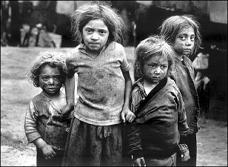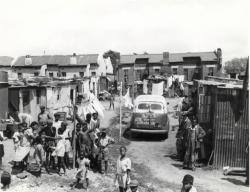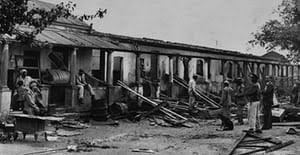
|
Unbanned Bible Publications |
|
Defending God’s Truth in Church Doctrine and Political History – Renette Vermeulen |
|
The Riotous Assemblies Act 19 - 1930. “It empowered the Government to prohibit the publication and dissemination of any 'documentary information’ ... calculated to engender feelings of hostility between the European inhabitants of the [British] Union on the one hand and any other section of the inhabitants on the Union on the other… According to Simons & Simons (1969: 430), this amendment aimed to ‘curb the liberation movement.’” [What had this act to do with land ‘taking?’ It was to curb civil and terrorist revolt like indiscriminate bombings. Civil unrest and terrorism were also restricted in other countries under the threat of civil revolution and border war.]
The Asiatic Immigration Amendment Act of 1931. “The [great influx of] Indians have to prove the legitimacy of their domicile in the country.” [What does this have to do with land-’taking?’ Isn’t this how every other country is still governed — including the New South Africa?]
The Native Service Contracts Act of 1932. [This too, was not land-’taking.’] “Simons & Simons (1969: 423)’ Davenport (1987: 295)… It was [the] legalized whipping of African lads under eighteen for offences against the Master and Servant Laws. [Lawbreakers under eighteen of any other race group, instead of being sent to reformed schools or prisons, received the same punishment for theft, etc.] Authorized African guardians [were] to bind minor children to labour, and aimed at turning share croppers into labour tenants, working from ninety to 180 days a year for the farmer on the days of his choice" [These days coincided with the planting and harvest of crops.] (Simons & Simons 1969: 452t). It also "enabled farmers to call on the labour of their workers' families as well as the workers themselves; [during planting and harvest times, more labourers were required,] to evict them summarily for non-performance of labour obligations even if there were no written contract of service," (Davenport 1987: 295)... [This was not just about African people. Such contracts did not exist in informal employment. I was 12 years old when I began to work at a packing factory every school holiday, standing on my feet the whole day to earn R11.00 a week, for which I was truly grateful. On the slightest suspicion of laziness or incompetence, workers of all races were immediately dismissed. Theft, corruption, etc., called for arrest, a court hearing, and if found guilty, beating by law enforcement officers according to the severity of the offense.] Furthermore, [apartheid laws] "forced all tenants on white-owned farms either to work between three and six months per year for the landowner or to pay a heavy £5 tax [or tenant fees, because they were/are living on and off his land,] and it also prevented them from leaving the farm without written permission," [because of the laws that curbed terrorist activities.] (Worden 1994: 60). Incidentally, while the churches protested heavily against it, the ANC objected only to not having been consulted, (Simons & Simons 1969: 453).”
The Native Trust and Land Act of 1936 (Act 18). “The Native Trust and Land Act, 1936… served as the reorganization of agricultural structures… This ordinance stipulated that the reserved land, which the black population in the Natives Land Act, 1913 had been allocated of 7.13% (9,709,586 acres) to enlarge to approximately 13.6% of the total area of the then [still British] South Africa… This value was not reached and remained so unfulfilled until the 1980s. (Reference 1.) In 1972 the government purchased 1,146,451 acres to meet this requirement in the “Homelands.” [The many independent States, which the Government gave to African tribes in South Africa according to the concentration of their numbers in these areas.] In view of the fact that the black population accounted for at this time about 61% in the general population, this area ratio was too small. [Vast overpopulation, which could not be sustained by natural and other resources, was always an issue.] During the world economic depression damage occurring to agricultural land through erosion and overgrazing, played a relevant role in the preparation of the Act. [This was also because of incorrect and neglected agricultural techniques.] At the same time the rights of the black people were as tenant farmers restricted to white owners. From then on, blacks were only allowed to live on farms… This selling pressure caused by the Act forced many blacks to seek work in salaried employment outside of their family and tribal tradition rooted in residential areas. Destinations of these migrations were the farms of whites and the cities, preferably industrial urban centres...” [This caused a devastating breakdown in family structures and chaos in the already overcrowded cities.]
The Slums Act of 1934. [After the Boer War, immense poverty affected all races of South Africa, who, in search of a living, totally overcrowded the cities. This resulted in slum areas everywhere in and around the cities, where all races were crammed together.]
[Acknowledgement to those who compiled the photos and images in this study]
The Slums Act focussed on the demolition of various inner, dilapidated suburbs… The displaced African populations were largely re-housed in segregated mono-racial municipal housing estates on the urban periphery” (Christopher 1994: 38.) Thus, by proclaiming certain non-white areas as slums,’ these areas could be condemned and people moved with overtly ‘non-racial’ motives. [These areas were really slums and breeding grounds for alcoholism and drug abuse, prostitution, violent crimes and deeper deprivation.] “The Slum Clearance Act, passed in 1934, enabled municipalities to forcibly remove people who were settled in areas that were considered to be slums. As a result of the forced removals arising from the Act in Port Elizabeth, the population of New Brighton increased from 7,827 to 16,574. (History Online) [How is this overpopulation related to the move of people from one area to another, bad as this was? But isn’t demolishing dilapidated informal and other settlements and relocating people, also part of the new ANC government’s law enforcement?] […This act] is shown to have significantly eroded residential opportunities of African people in Johannesburg… controlling the location of coloured and Indian housing and entrenching separate residential areas for poor whites…” (South African Geographical Journal) 1934.
The 1954 Native Resettlement Act. “[This law] authorised the forced removal of Africans from any area in the magisterial district of Johannesburg.” It was specifically instituted to displace Africans from Sophiatown, a largely African township… Sophiatown menaced the White regime for reasons including… its high incidence of gang violence and violent resistance to apartheid legislation; its increasingly vocal community of [violent] political activists; and its proximity to other (white) Johannesburg townships… By 1955, when the removals began, the Government’s creation of new administrative bodies (such as the 1953 Natives Resettlement Board) and new laws (such as the 1954 Native Resettlement Act) overpowered African opposition.”
[Acknowledgement to those who compiled the photos and images in this study]
“Sophiatown, Newclare, and Martindale, the western townships of Johannesburg collectively known as the Western Areas,” constituted the most significant African urban settlement in South Africa during the 1940s and 1950s. The Western Areas was also the centre of political activism, fronted by the African National Congress (ANC) and the Communist Party. Between 1955 and 1963, [under fierce fighting and riotous protest,] Africans were evicted from the area. Sophiatown was bulldozed, reconstructed as a white township, and renamed Triomf (“Triumph”), designating the event as a proud accomplishment of the apartheid regime (1948-94) (Goodhew, xv-xvi). “The South African government passed some 100 laws between 1919 and the 1970s in order to channel the country into a spatial and demographic reconfiguration like that which proceeded in the Western Areas (Kane-Berman, 70). This initiative took place in full throttle after 1948 with the inauguration of Apartheid. The principle of racial segregation and disenfranchisement in South Africa, however, was much older, and federal efforts to standardise this policy were made as early as 1913 (Ibid., 71).
The Development Trust and Land Act of 1936 (Act 18) “[This act is] ...a law that served as the reorganization of agricultural structures… [It] stipulated that the reserve land, which the black population in the Natives Land Act, 1913 had been allocated of 7.13% (9,709,586 acres) to enlarge to approximately 13.6% of the total area of the then South Africa. This value was not reached and remained so unfulfilled until the 1980s. (Reference 1) [By] 1972 the government purchased 1,146,451 acres to meet this requirement in the homelands. In view of the fact that the black population accounted for at this time about 61% in the general population, this area ratio was [still too] small. During the world economic depression damage occurring to agricultural land through erosion and overgrazing played a relevant role in the preparation of the Act. At the same time the rights of the black people were as tenant farmers restricted to white owners. From then on, blacks were only allowed to live on farms, which were owned by whites, and the black employees worked on them. This selling pressure caused by this Act forced many blacks to seek work in salaried employment outside of their family and tribal tradition rooted in residential areas. Destinations of these migrations were the large farms of the whites and the cities, preferably industrial urban centres.” [Wikipedia.]
The Rural Dealers Licensing Act of 1935. “Anti-India legislation Act 3, 1935: The Rural Dealers Licensing Ordinance, Natal - This Ordinance causes the refusal of licenses to people whose properties have depreciated in value or whose licenses endangers the comfort and health of neighbours. [This was to fight slum-invasion and shady deals that depreciated neighbouring better-off suburbs.]”
The Representation of Blacks Act 12 of 1936. [This law was a restriction on voting numbers in mass populations.] “…The Cape province… allowed a small number of blacks in the Cape to vote for the common roll, [does anyone know that they had any voting rights,] although not to sit in parliament… [It] dated back to… when the Cape was a British colony that also excluded poorer white men. The 1936 Act removed blacks to a separate roll – and halted their right to run for office… The small black elite - most blacks never had the vote - were removed from the common rolls on which they had been able to register since 1854…”
The Black (Native) Laws Amendment Act 46 of 1937. [This too, cannot be viewed as a land-’taking’ act, but must be interpreted in the light of terrorist activities and vast overpopulation.] “…This apparently restricted the mobility of the Black population, and also set a limit on "the size of the African urban population to the bare number needed for 'reasonable labour requirements' "(Simons & Simons 1969: 499)…” [The latter of this law was completely unenforceable.]
The Pegging Act of 1946. “This act restricted Indian purchase, [rich Indian businessmen could always buy everything they chose.] It was also known as the Ghetto Act and was more restrictive than the Pegging Act. It prohibited Indians from purchasing land from non-Indians except in specified areas. It further prevented Indians from occupying property from the exempted areas…”
The group areas act of 1950 (Act. 41) “This act… assigned racial groups to different residential and business sections in urban areas. An effect of the law was to prevent non-whites from living in the most developed [white demarcated] areas.” [There were several rich areas demarcated for other races such as Lenasia south of Johannesburg.]
(Continue) |





